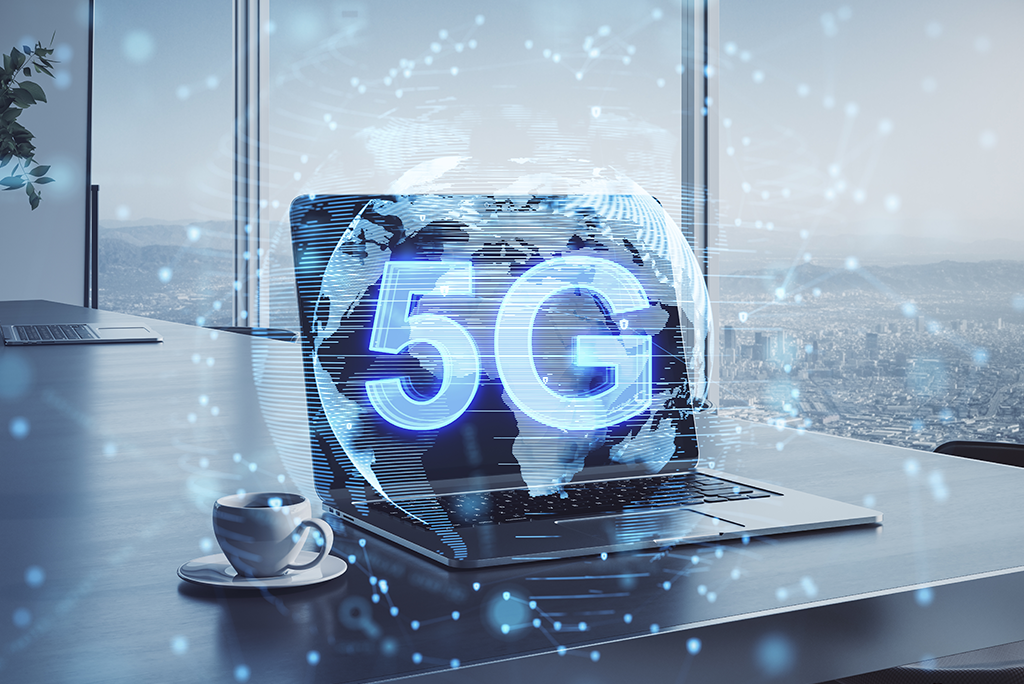
5G has been publicized as a substantial change in mobile networking—promising faster download speeds, real-time data-sharing, and network capacity. As such, the technology is expected to transform mobile networking and create new economic opportunities. Despite delays with the rollout in both the U.S. and parts of Europe, 5G has reached much of the globe. South Korea, the U.S., and China are leading the implementation with around 80-90% population coverage. Although Europe overall is trailing behind, Switzerland has reached 90%. A 2021 report from Ericsson projects 5G will account for nearly half of all mobile subscriptions by 2027 while also becoming mainstream in each of the report’s ten studied regions. Though challenges persist for deployment globally, technology providers are optimistic about the future of 5G.
Forecasts for Industry
While the majority of 5G-supported or enabled applications today are consumer-based (think mobile streaming, augmented reality, virtual reality, and gaming), many experts believe the real money will be in enterprise applications of 5G. In its 5G value report, KPMG estimated the business-to-business case at US$4.3 trillion. Across industries—from factory automation and large-scale video surveillance to remote surgery and connected smart cities— there are a number of potentially groundbreaking use cases.
5G enables fast, secure, and pervasive connectivity across smart networks and Internet of Things (IoT) devices. When combined with artificial intelligence, 5G can enable unparalleled productivity and efficiency. Apart from the global estimate, five industries are poised to see incremental growth: Industrial Manufacturing, Connected Healthcare, Intelligent Transportation, Environmental Monitoring, and Gaming. KPMG estimates the market across the ecosystem for these five industries will be worth more than US$500B by 2023.
Managing Expectations
Before organizations adopt 5G, they should understand the differences between 4G and 5G network architectures to understand how both could affect business operations. Small cell technology enables 5G to provide more cell density and enhance network capacity. While 4G technology also made similar promises, experts anticipate 5G will succeed where its predecessor falls short. However, it is essential to understand that there are still 5G issues, and it may take years to reach its full potential.
Health Concerns Regarding 5G
When you use your phone to communicate with other devices, cellular data is sent through radio frequencies (RFs). “The radiofrequency 5G is higher than the previous iterations of wireless communication, including 4G and 3G”, says Henk De Feyter, Ph.D., an assistant professor of radiology and biomedical imaging at Yale School of Medicine in New Haven, Connecticut. In a world of propaganda and misinformation about 5G, how are policymakers and the public supposed to make sense of any individual claim? (For example, various internet theories have tied 5G technology to cancer and COVID-19.)
Learn more about this topic by watching 5G Demystified: Health and Safety of 5G, an on-demand LinkedIn Live recording where our speakers discuss the science and standards of human health effects from electromagnetic radio waves in 5G communications. Watch now>>
More Ways to Explore Current 5G Issues with IEEE
Depending on what you read, 5G is either a threat to society, the impetus for the next industrial revolution, or a marketing ploy to get us to buy new phones and tablets. Seldom has an emerging technology been so widely known yet so misunderstood. IEEE Future Networks and IEEE Educational Activities have developed a free virtual event series, 5G Demystified, where experts make sense of the technology’s potential.
Check out the events in this series:
Plus, check out these online course programs and earn continuing education credits while growing your knowledge of telecommunications technology!
Bridging the 4G/5G Gap: Telecommunications Roadmap for Implementation: This two-part course program provides a historical overview of 4G/5G, explains the legislative and regulatory background, showcases the scientific evidence surrounding wireless facilities’ impact on property value and human health, and offers a roadmap to deploy wireless facilities. Learn more>>
5G Networks: Produced in partnership with Nokia, this online course program provides an in-depth view of performance requirements, future scenarios, and the roadmap to 5G implementation. It also explores the intricacies of 5G standardization by the 3rd Generation Partnership Project (3GPP) and the IEEE 802 LAN/MAN Standards Committee. Learn More>>
Resources
Ericsson. (November 2021). Ericsson Mobility Report.
Goss, Michaela. (November 2022). 5G vs. 4G: Learn the key differences between them. TechTarget.
Holt, Alex. (June 2020). The 5G edge computing value opportunity. KPMG.
Laurence, Emily. (31 May 2022). Is 5G Making You Sick? Here’s What Experts Say. Forbes.
Vella, Heidi. (17 February 2022). 5G vs 4G: what is the difference? Raconteur.


No comments yet.